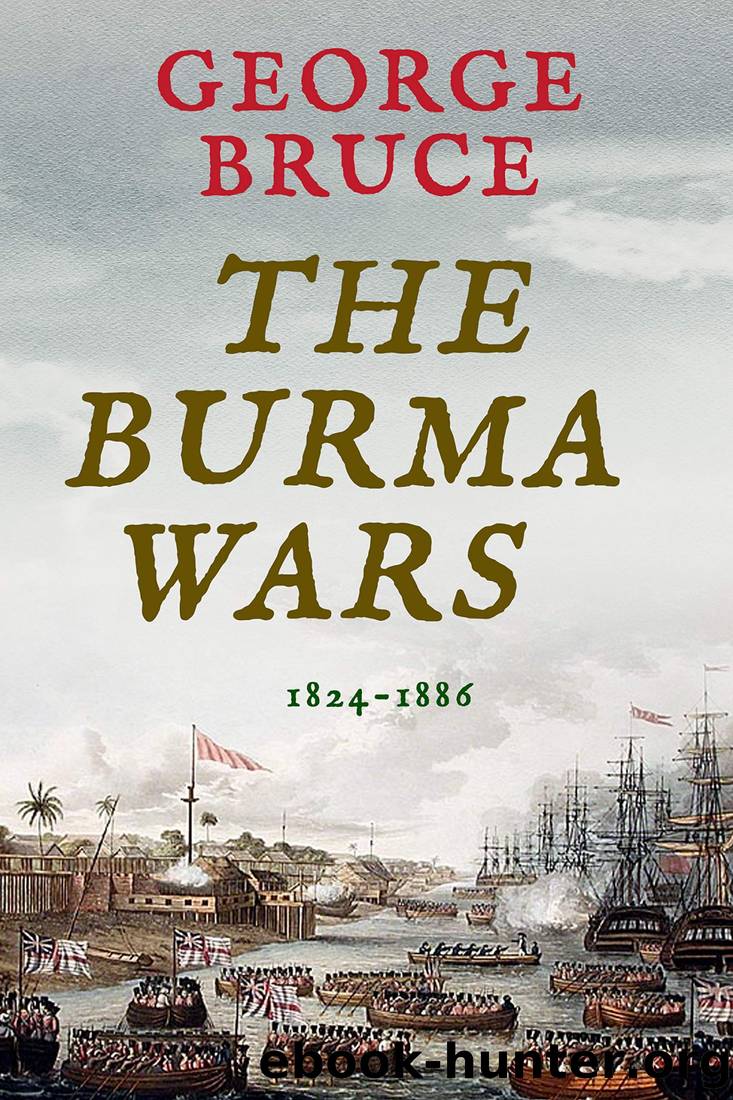The Burma Wars: 1824-1886 (Conflicts of Empire) by George Bruce

Author:George Bruce [Bruce, George]
Language: eng
Format: epub
Publisher: Sapere Books
Published: 2021-05-22T22:00:00+00:00
Spies, assassins and incendiaries lurked in every corner of Rangoon; every native within our lines became an object of suspicion and the utmost vigilance of the troops, combined with the energy and decision of their commander, could alone have prevented our losing every advantage of our late successes, by the destruction of our stores and magazines⦠The inflammable materials of which the town was composed required but a single fire-brand to envelope [sic] our cantonments and everything they contained in a general conflagration; while the unseen enemy, lurking in the outskirts of the jungle, were held in constant readiness to rush in upon our lines during the confusionâ¦
These fears were justified. At midnight on 12 December fire broke out in several places at once in windward parts of the town. Helped by a high wind the flames swept through the thatch and bamboo houses with extraordinary violence until it looked as though they would reach the ammunition and stores depot in an adjoining area.
Expecting the Burmese to make a lightning attack during the confusion, Campbell ordered the drums to beat to arms for picquets to man the defence. At the same time companies of men ran off at the double through the surging smoke and the showers of sparks to try to stop the blaze reaching the danger area.
Exactly how this was done â by a human chain of water buckets, by thousands of men beating out the flames or destroying the flimsy houses and removing all timber from the fireâs path â not even the meticulous Snodgrass reported, but after two hours, the flames were âcompletely got underâ, with only slight damage to military property â and the destruction of a quarter of the town.
Surveying the smoking ruins â evidence of Bundulaâs power â next day, Campbell determined to undertake the risky task of sending a force through the jungle to Kokeen after him as soon as possible, which was two days later, 15 December. He must have realised that the time had come for him to regain the initiative, despite the risks.
They were considerable for, first, with their numerical superiority, excellent sources of information and perfect knowledge of the jungle, the Burmese might overcome Rangoon while many of his troops were away assailing the Kokeen stockade. Secondly, he would have to march this force through the winding jungle footpaths where the Burmese snipers, from trees and thicket, could knock out hundreds of his men long before he reached Bundulaâs stronghold. Finally, he would have to order his troops to attack without artillery a fieldwork stronger than any they had yet faced, for they could take only one or two light guns.
But he had no choice, and early on 15 December, having left about 3,000 men to hold Rangoon and the Shwedagon he moved out against Bundula in two columns, the right of 340 men, British and Indian, under Brigadier-General Cotton, and the left, 800 strong, under his personal command. Cottonâs force was to make a detour and attack from the rear, while Campbellâs took them from the front.
Download
This site does not store any files on its server. We only index and link to content provided by other sites. Please contact the content providers to delete copyright contents if any and email us, we'll remove relevant links or contents immediately.
| Africa | Americas |
| Arctic & Antarctica | Asia |
| Australia & Oceania | Europe |
| Middle East | Russia |
| United States | World |
| Ancient Civilizations | Military |
| Historical Study & Educational Resources |
Wabi sabi by Kempton Beth(720)
Mr. Selden's Map of China by Timothy Brook(601)
Heroic Hindu Resistance To Muslim Invaders (636 AD to 1206 AD) by Sita Ram Goel(573)
Akbar: The Great Mughal by Ira Mukhoty(542)
The Meaning of India by Raja Rao(537)
Vedic Physics: Scientific Origin of Hinduism by Raja Ram Mohan Roy(535)
Banaras by Diana L. Eck(526)
Philippines--Culture Smart! by Culture Smart!(502)
Mao's Great Famine: The History of China's Most Devastating Catastrophe, 1958-1962 by Frank Dikötter(500)
Food of India by unknow(496)
China Unbound by Joanna Chiu(486)
How to Be a Modern Samurai by Antony Cummins(473)
India--Culture Smart! by Becky Stephen(472)
A History of Japan by R.H.P. Mason & J.G. Caiger(467)
Insurgency and Counterinsurgency by Jeremy Black(465)
North of South by Shiva Naipaul(461)
The Genius of China: 3,000 Years of Science, Discovery, and Invention by Robert Temple(446)
Kim Jong Un and the Bomb by Ankit Panda(430)
The Digital Silk Road by Jonathan E. Hillman(422)
